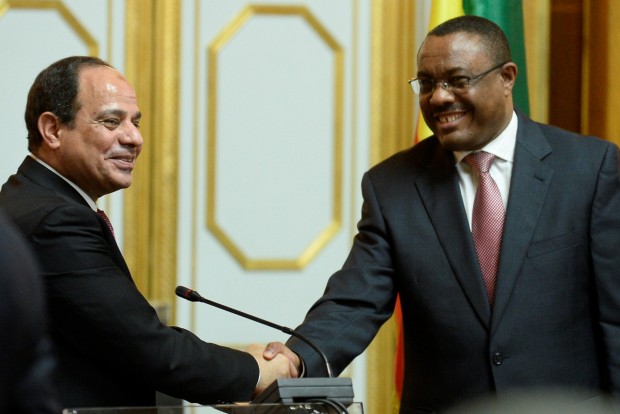Egypt and Ethiopia attempt settling Renaissance Dam project

Egyptian President Fattah al-Sisi (L) shakes hands with Ethiopian Prime Minister Hilemariam Desalegn during a press conference after their meeting on issues of security in Africa ,bilateral relations and Grand Ethiopian Renaissance Dam (GERD), which Ethiopia is building over the Nile River, in Addis Ababa, Ethiopia, on March 24, 2015. (Xinhua/Michael Tewelde)(zhf)
Egypt and Ethiopia signed a deal in Sudan called “Khartoum Document” in the presence of foreign and irrigation ministers of the three countries to try to reach a final resolution regarding Ethiopia’s Renaissance Dam, on Tuesday 29th December.
The document includes information on the new international company that will conduct studies on Ethiopia’s Renaissance Dam, Sudan’s Foreign Minister Ibrahim Ghandour said. As he added that the french company “Artelia” will carry out the studies alongside the company “BRL”, after the Dutch company “Deltares” backed out of the deal in September citing that there were no guarantees that an independent and high quality study could be carried out.
Sudan’s foreign minister’s statements come as his country, along with Egypt’s foreign Sameh Shoukry minister and Ethiopia’s foreign minister Tawadros Idhanom, are still trying to reach a consensus on the construction of what would be Africa’s largest dam.
“It has been agreed upon that the studies would be wrapped up quickly because they are related to the overall work on the dam,” Ghandour said, according to Egypt’s state news agency MENA.
Earlier on Tuesday, Egypt’s foreign ministry spokesperson Ahmed Abu Zeid wrote on his Twitter account that “Egypt, Ethiopia & Sudan reached consensus on the following steps on the GERD (Renaissance Dam) project in full commitment with the declaration of principles.”
Earlier 2015, the March declaration, signed by Egypt’s President Abdel-Fattah El-Sisi, Ethiopia’s Prime Minster Hailemariam Desalegn and Sudan’s President Omar Al-Bashir included 10 articles on the establishment of the dam; but the declaration has been criticized by some experts who described it as loose and vague.
According to Egypt’s “AlAhram”, Ghandour reiterated that the principles were agreed upon to build trust between the three countries.
As Ayman Shabana, deputy director of the Sudanese Studies Centre at Cairo University, told Ahram that the first filling of the Renaissance dam will reserve the biggest amount of water compared to the following filling rounds, which means that Egypt might face a sudden shortage of water.
“The option which the Egyptians have right now is to negotiate for prolonging the filling time for the dam from an average four to six years to a concrete six years, as well as reducing the dam’s 74 million cubic meter storage capacity,” Shabana said.
Cairo has repeatedly expressed concerns that filling and operating the dam, which is being built on the Blue Nile, will reduce the supply of Nile water that reaches downstream Egypt, despite Ethiopia continually rejecting these claims.
Ethiopia said several times that the dam solely aims to produce electricity, amid fears that Egypt’s share of Nile water, that stands currently at 55 billion cubic meters, would be reduced, as pointed out by Egypt’s Ahram Online.

























































